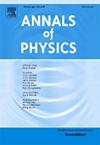Imprints of torsion-like Rastall theory in the construction of wormholes exhibiting conformal motion
IF 3
3区 物理与天体物理
Q2 PHYSICS, MULTIDISCIPLINARY
引用次数: 0
Abstract
In current study, we are looking into the possibility of wormhole construction by involving conformal killing vectors in torsion-like Rastall gravity. To meet this goal, a wormhole geometry with static and spherically symmetric features is taken into account where the ordinary matter exhibits anisotropic nature. For obtaining exact wormhole functions, we consider four recently proposed dark matter density models namely Navarro–Frenk–White dark matter density, universal rotation curve dark matter density model, scalar field dark matter model, and pseudo isothermal dark matter profile. A comprehensive graphical analysis of different parameters is then performed for revealing the physical significance of developed wormhole solutions. In this respect, we explore behavior of wormhole shape model, validity of null energy bounds, EoS parameters, volume integral quantifier, exoticity and anisotropic parameters in each case for different Rastall parameter’s variations. Further, stability of these solutions is demonstrated through graphical analysis of TOV forces as well as adiabatic index. It is seen that all wormhole models exhibit valid behavior but do not satisfy the asymptotic flatness property. It is seen that stability of these solutions can be achieved for certain choices with large values.
在虫洞构造中显示保形运动的类扭拉斯托理论的印记
在目前的研究中,我们正在探讨在类扭拉斯托引力中引入保形杀伤矢量来构建虫洞的可能性。为了实现这一目标,考虑了具有静态和球对称特征的虫洞几何形状,其中普通物质具有各向异性。为了获得精确的虫洞函数,我们考虑了最近提出的四种暗物质密度模型,即Navarro-Frenk-White暗物质密度模型、万向旋转曲线暗物质密度模型、标量场暗物质模型和伪等温暗物质剖面。然后进行了不同参数的综合图形分析,以揭示所开发的虫洞解决方案的物理意义。在这方面,我们探讨了虫洞形状模型的行为,零能界的有效性,EoS参数,体积积分量子,异域性和各向异性参数在每种情况下不同的Rastall参数的变化。此外,通过TOV力和绝热指数的图形分析证明了这些解的稳定性。结果表明,所有虫洞模型都表现出有效的行为,但不满足渐近平坦性。可以看出,对于具有较大r值的某些选择,这些解的稳定性是可以实现的。
本文章由计算机程序翻译,如有差异,请以英文原文为准。
求助全文
约1分钟内获得全文
求助全文
来源期刊

Annals of Physics
物理-物理:综合
CiteScore
5.30
自引率
3.30%
发文量
211
审稿时长
47 days
期刊介绍:
Annals of Physics presents original work in all areas of basic theoretic physics research. Ideas are developed and fully explored, and thorough treatment is given to first principles and ultimate applications. Annals of Physics emphasizes clarity and intelligibility in the articles it publishes, thus making them as accessible as possible. Readers familiar with recent developments in the field are provided with sufficient detail and background to follow the arguments and understand their significance.
The Editors of the journal cover all fields of theoretical physics. Articles published in the journal are typically longer than 20 pages.
 求助内容:
求助内容: 应助结果提醒方式:
应助结果提醒方式:


